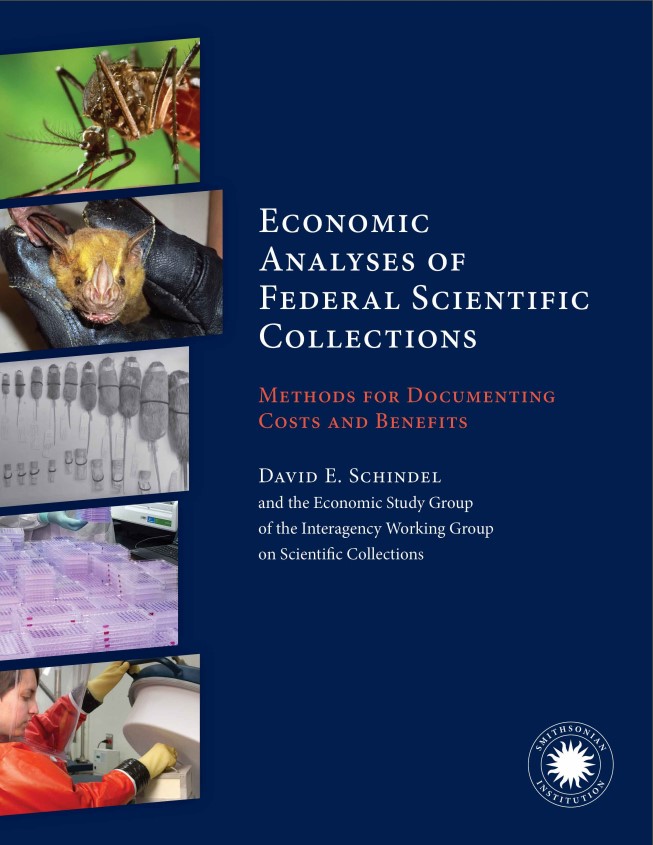Report Highlights Long-Term Benefits of Scientific Collections
The Smithsonian Institution Scholarly Press has published a report exploring the benefits of the nation’s scientific collections. The report, a joint effort of 15 federal departments and agencies led by the Smithsonian and the U.S. Department of Agriculture (USDA), provides illustrative examples of the many ways federal scientific collections serve the nation, from vaccine development to earthquake preparedness.
While the report focuses on federal collections, it also serves as a guide for other museums, universities, research institutions and industries. The publication offers evidence-based methods for measuring the benefits of scientific collections against the costs of maintaining them.
The report, Economic Analyses of Federal Scientific Collections: Methods for Documenting Costs and Benefits, was commissioned by the Interagency Working Group on Scientific Collections (IWGSC), part of the White House National Science and Technology Council. IWGSC is co-chaired by the Smithsonian and USDA.
“Although the report is focused on federal scientific collections, its content applies to myriad collections and leads to many public benefits,” said Scott Miller, Smithsonian chief scientist and IWGSC co-chair. “The report is especially timely given the economic stress on research and organizations because of COVID-19.”
Federal scientific collections are diverse and immense. The Smithsonian’s National Museum of Natural History alone has more than 146 million specimens and samples in its collections, acquired from the oceans to outer space––including plants, animals and insects; rocks, minerals and meteorites; and fossils and human artifacts.
Institutions like the Smithsonian preserve these vast collections for research, education and public outreach. They offer a wide variety of benefits for the nation, from insurance against future emergencies to the development of new technologies. Examples from the report highlight how USDA’s collections of agricultural pests help protect the U.S. food supply, or how a bacteria sample from a national park provided the basis for a major biotechnology breakthrough.
The authors note that demonstrating the long-term value of scientific collections can help institutions preserve these vital services for the future.
“USDA’s agricultural collections are some of the largest and most diverse in the world,” said Dionne Toombs, director of USDA’s Office of the Chief Scientist and IWGSC co-chair. “We are proud to be stewards of these valuable resources that ensure the preservation, diversity and safety of these collections for current and future generations.”
The report and related resources can be accessed at https://iwgsc.nal.usda.gov/economic-analyses-federal-scientific-collections.
About the Smithsonian
Since its founding in 1846, the Smithsonian Institution has been committed to inspiring generations through knowledge and discovery. It is the world’s largest museum, education and research complex, consisting of 19 museums, the National Zoological Park, education centers, research facilities, cultural centers and libraries. There are more than 6,300 Smithsonian employees and 6,900 volunteers. There were more than 22 million visits to the Smithsonian in 2019. The total number of objects, works of art and specimens at the Smithsonian is estimated at nearly 155 million, of which nearly 146 million are scientific specimens at the National Museum of Natural History.
About the Interagency Working Group on Scientific Collections
The Interagency Working Group on Scientific Collections was established in 2005 as a forum for collaboration and coordination among federal departments and agencies with object-based scientific collections. The IWGSC promotes responsible stewardship of the object-based scientific collections that serve the missions of the U.S. federal government.
About the U.S. Department of Agriculture
USDA provides leadership on food, agriculture, natural resources, rural development, nutrition and related issues based on public policy, the best available science and effective management. USDA’s vision is to provide economic opportunity through innovation, helping rural America to thrive, to promote agriculture production that better nourishes Americans while also helping feed others throughout the world and to preserve our nation’s natural resources through conservation, restored forests, improved watersheds and healthy private working lands.
# # #
SI-363-2020

